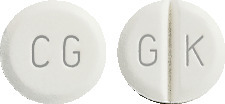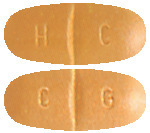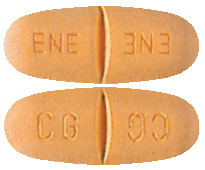SUMMARY CMI
Tegretol®
Consumer Medicine Information (CMI) summary
The full CMI on the next page has more details. If you are worried about using this medicine, speak to your doctor or pharmacist.
1. Why am I using Tegretol?
Tegretol contains the active ingredient carbamazepine. Tegretol is used to control epilepsy (fits); sudden repeated attacks of face pain; mania (overactivity, excessive happiness/irritability); bipolar mood disorder (mania alternating with depression). For more information, see Section 1. Why am I using Tegretol? in the full CMI.
2. What should I know before I use Tegretol?
Do not use if you have ever had an allergic reaction to carbamazepine, related medicines or any of the ingredients listed at the end of the CMI. Talk to your doctor if you have any other medical conditions, take any other medicines, or are pregnant or plan to become pregnant or are breastfeeding.
For more information, see Section 2. What should I know before I use Tegretol? in the full CMI.
3. What if I am taking other medicines?
Some medicines may interfere with Tegretol and affect how it works.
A list of these medicines is in Section 3. What if I am taking other medicines? in the full CMI.
4. How do I take Tegretol?
- Your doctor will tell you how much Tegretol to take. Tegretol tablets may be taken during or after meals with a little liquid.
More instructions can be found in Section 4. How do I take Tegretol? in the full CMI.
5. What should I know while taking Tegretol?
| Things you should do |
|
| Things you should not do |
|
| Driving or using machines |
|
| Drinking alcohol |
|
| Looking after your medicine |
|
For more information, see Section 5. What should I know while taking Tegretol? in the full CMI.
6. Are there any side effects?
Swelling in any part of the body, tiredness/sleepiness, weight increase, vomiting, confusion, hair loss, fever, difficulty breathing, feeling sick, seizures, dry mouth, fainting/dizziness, less coordination, trouble speaking, muscle weakness/pain, numbness or tingling, change in sense of taste, hallucinations, depression, agitation, aggression, eating disorder, restlessness, confusion, blurred vision, double vision, red or swelling eye/s, vision loss and eyes appear milky, red, itchy skin or any other skin problems.
For more information, including what to do if you have any side effects, see Section 6. Are there any side effects? in the full CMI.
FULL CMI
Tegretol®
Active ingredient(s): carbamazepine
Consumer Medicine Information (CMI)
This leaflet provides important information about using Tegretol. You should also speak to your doctor or pharmacist if you would like further information or if you have any concerns or questions about using Tegretol.
Where to find information in this leaflet:
1. Why am I using Tegretol?
2. What should I know before I use Tegretol?
3. What if I am taking other medicines?
4. How do I take Tegretol?
5. What should I know while taking Tegretol?
6. Are there any side effects?
7. Product details
1. Why am I using Tegretol?
Tegretol contains the active ingredient carbamazepine. Tegretol is an anticonvulsant (medicines that prevent or reduce fits).
Tegretol is used to control epilepsy, a condition in which there are repeated seizures (fits).
Tegretol is also used to control sudden repeated attacks of face pain (known as trigeminal neuralgia).
Tegretol is used to control mania, a mental condition where overactivity, excessive happiness or excessive irritability occurs.
Tegretol is also used to control bipolar mood disorder, where periods of mania alternate with periods of depression.
2. What should I know before I use Tegretol?
Warnings
Do not use Tegretol if:
- you are allergic to carbamazepine or related medicines, or any of the ingredients listed at the end of this leaflet.
- you are taking tricyclic antidepressants, which are medicines use to treat depression.
- you have a blood disease where there are a low number of red or white blood cells or platelets.
- you have a condition which causes the immune system to attack its own tissues, called SLE (Systemic lupus erythematosus).
- you have an irregular heartbeat caused by a condition called A-V block.
- you have hepatic porphyria, a disturbance in the production of porphyrin, a pigment important for liver function and blood formation
- you have severe liver disease
- baby is less than 4 weeks of age
Always check the ingredients to make sure you can use this medicine.
Some symptoms of an allergic reaction may include shortness of breath, wheezing or difficulty breathing; swelling of the face, lips, eyelids, throat, mouth, tongue or other parts of the body; rash, itching or hives on the skin.
Check with your doctor if you:
- have any other medical conditions such as blood illnesses; heart, liver or kidney disease; prostate problems
- have glaucoma
- take any medicines for any other conditions
- have problems with your blood caused by other medicines
- have mental disorders such as depression or schizophrenia
- are allergic to oxcarbazepine, the active ingredient in Trileptal, or phenytoin. These medicines also treat Epilepsy.
During treatment, you may be at risk of developing certain side effects. It is important you understand these risks and how to monitor for them. See additional information under Section 6. Are there any side effects?
Pregnancy and breastfeeding
Check with your doctor if you are pregnant or intend to become pregnant.
There is a possible risk of physical birth abnormalities to your baby if you take this medicine during pregnancy.
Talk to your doctor if you are breastfeeding or intend to breastfeed. Tegretol passes into breast milk. If your baby develops a skin rash, becomes sleepy or has any other unusual symptoms, do not breast feed again until you speak to your doctor.
You should avoid becoming pregnant while using Tegretol and for 2 weeks after you stop using it.
If you are a female of child-bearing age and are taking hormonal birth control medicines (the pill), you should use additional or different non-hormonal birth control.
Asian descent, especially Chinese or Thai
- Serious skin reactions could occur in patients of Han Chinese or Thai origin.
- A blood test may be required before taking Tegretol.
Monoamine oxidase inhibitors (MAOI)
- Do not take Tegretol in combination with MAOIs, or within 14 days of taking MAOIs.
- Combination of these medicines may cause a sudden increase in body temperature, extremely high blood pressure and severe convulsions.
3. What if I am taking other medicines?
Tell your doctor or pharmacist if you are taking any other medicines, including any medicines, vitamins or supplements that you buy without a prescription from your pharmacy, supermarket or health food shop.
Some medicines may interfere with Tegretol and affect how it works.
Medicines that may increase the effect of Tegretol include:
- ibuprofen
- dextropropoxyphene
- danazol
- macrolide antibiotics (e.g. erythromycin, troleandomycin, josamycin, clarithromycin), ciprofloxacin
- possibly desipramine, fluoxetine, fluvoxamine, nefazodone, paroxetine, trazodone
- vigabatrin
- azoles (e.g. itraconazole, ketoconazole, fluconazole, voriconazole)
- loratadine, terfenadine
- olanzapine, quetiapine
- isoniazid
- protease inhibitors for HIV treatment (e.g. ritonavir)
- acetazolamide
- diltiazem, verapamil
- possibly cimetidine, omeprazole
- oxybutynin, dantrolene
- ticlopidine
- nicotinamide (in adults, only in high dosage)
- levetiracetam
Medicines that may reduce the effect of Tegretol include:
- oxcarbazepine, phenobarbital, phenytoin, primidone, progabide, clonazepam, valproic acid or valpromide, brivaracetam
- cisplatin or doxorubicin
- rifampicin
- theophylline, aminophylline
- isotretinoin has been reported to alter the bioavailability and/or clearance of carbamazepine and carbamazepine-10, 11-epoxide
- St John's wort
Tegretol may affect how other medicines work, including:
- buprenorphine, methadone, paracetamol (long term administration of carbamazepine and paracetamol may be associated with hepatotoxicity), tramadol
- doxycycline, rifabutin
- oral anticoagulants (warfarin, phenprocoumon, dicoumarol, acenocoumarol, rivaroxaban, dabigatran, apixaban, edoxaban)
- bupropion, citalopram, mianserin, nefazodone, sertraline, trazodone, tricyclic antidepressants (e.g. imipramine, amitriptyline, nortriptyline, clomipramine)
- aprepitant
- clobazam, clonazepam, ethosuximide, lamotrigine, eslicarbazepine, oxcarbazepine, primidone, tiagabine, topiramate, valproic acid, phenytoin, mephenytoin
- Itraconazole, voriconazole
- praziquantel, albendazole
- imatinib, cyclophosphamide, lapatinib, temsirolimus
- clozapine, haloperidol, bromperidol, olanzapine, quetiapine, risperidone, ziprasidone, aripiprazole, paliperidone
- protease inhibitors for HIV treatment, (e.g. indinavir, ritonavir, saquinavir)
- alprazolam, midazolam
- theophylline
- hormonal contraceptives (oestrogens and/or progesterones)
- calcium channel blockers (dihydropyridine group), e.g., felodipine, digoxin, simvastatin, atorvastatin, lovastatin, cerivastatin, ivabradine
- corticosteroids (e.g. prednisolone, dexamethasone)
- tadalafil
- cyclosporin, everolimus, tacrolimus, sirolimus
- levothyroxine
- isoniazid
- lithium or metoclopramide
- neuroleptics (haloperidol, thioridazine)
- selective serotonin re-uptake inhibitors
- diuretics (hydrochlorothiazide, frusemide)
- non-depolarising muscle relaxants (e.g. pancuronium)
- alcohol
- MAO inhibitors
- direct acting oral anti-coagulants (rivaroxaban, dabigatran, apixaban, and edoxaban)
Check with your doctor or pharmacist if you are not sure about what medicines, vitamins or supplements you are taking and if these affect Tegretol.
4. How do I take Tegretol?
How much to take
- Your doctor will tell you how much Tegretol to take
- Follow the instructions provided and use Tegretol until your doctor tells you to stop.
- Tegretol is available as tablets, controlled release tablets (CR) and as a liquid.
How to take Tegretol
- Tegretol tablets and Tegretol CR tablets - swallow with a full glass of water.
- Tegretol CR tablets - do not crush or chew.
- Tegretol liquid - shake the bottle well before measuring the dose.
When to take Tegretol
- Take Tegretol during or after a meal.
- Tegretol should be taken 2 or 3 times per day, according to your doctor's instructions.
If you forget to use Tegretol
Tegretol should be used regularly at the same time each day. If you miss your dose at the usual time and it is less than 2 or 3 hours to the next dose, take your dose as soon as you remember.
If it is almost time for your next dose (less than 2 or 3 hours to your next dose), skip the dose you missed and take your next dose when you are meant to.
Do not take a double dose to make up for the dose you missed.
If you use too much Tegretol
If you think that you have used too much Tegretol, you may need urgent medical attention.
You should immediately:
- phone the Poisons Information Centre
(by calling 13 11 26), or - contact your doctor, or
- go to the Emergency Department at your nearest hospital.
You should do this even if there are no signs of discomfort or poisoning.
5. What should I know while taking Tegretol?
Things you should do
- Keep all your doctor's appointments.
- If you are about to be started on any new medicine, remind your doctor and pharmacist that you are using Tegretol.
Remind any doctor, dentist or pharmacist you visit that you are using Tegretol.
Call your doctor straight away if you:
- become pregnant
- have thoughts about harming or killing yourself - all thoughts of suicide should be taken seriously
Things you should not do
- Do not stop using this medicine suddenly. This may worsen your fits.
- Do not lower your dose without first checking with your doctor.
- Do not give your medicine to anyone else, even if they have the same condition as you.
- Do not use Tegretol to treat any other complaints unless your doctor tells you to.
- Do not give Tegretol oral suspension to a baby less than 4 weeks of age.
Protection from sun
- Tegretol makes your skin more sensitive to sunlight. Wear protective clothing and sunscreen (at least SPF 15+) when outdoors. It may cause a skin rash, itching, redness or severe sunburn.
Driving or using machines
Be careful before you drive or use any machines or tools until you know how Tegretol affects you.
Tegretol may cause dizziness in some people. Tegretol can make you feel sleepy, cause you to have blurred vision, double vision or lower your coordination.
Children should avoid riding bikes or climbing trees while taking Tegretol.
Drinking alcohol
Do not drink alcohol while taking Tegretol.
This could cause sleepiness, dizziness or light-headedness.
Drinking grapefruit juice
Do not drink grapefruit juice while taking Tegretol.
Looking after your medicine
- Protect from moisture
- Store below 30°C
Follow the instructions on the carton on how to take care of your medicine properly.
Store it in a cool dry place away from moisture, heat or sunlight; for example, do not store it:
- in the bathroom or near a sink, or
- in the car or on windowsills.
Keep it where young children cannot reach it.
When to discard your medicine
Discard if it has passed the expiry date.
Getting rid of any unwanted medicine
If you no longer need to use this medicine or it is out of date, take it to any pharmacy for safe disposal.
Do not use this medicine after the expiry date.
6. Are there any side effects?
All medicines can have side effects. If you do experience any side effects, most of them are minor and temporary. However, some side effects may need medical attention.
See the information below and, if you need to, ask your doctor or pharmacist if you have any further questions about side effects.
Less serious side effects
| Less serious side effects | What to do |
General effects:
| Speak to your doctor if you have any of these less serious side effects and they worry you. |
Serious side effects
| Serious side effects | What to do |
| Call your doctor straight away, or go straight to the Emergency Department at your nearest hospital if you notice any of these serious side effects. |
Some side effects can only be found when your doctor does tests from time to time to check your progress. These include:
- Higher levels of liver enzymes
- Changes to your blood cells count, lipids and electrolytes
- Changes to the health of your eyes
- Abnormal thyroid function
- Heart function changes
Tell your doctor or pharmacist if you notice anything else that may be making you feel unwell.
Other side effects not listed here may occur in some people.
Reporting side effects
After you have received medical advice for any side effects you experience, you can report side effects to the Therapeutic Goods Administration online at www.tga.gov.au/reporting-problems. By reporting side effects, you can help provide more information on the safety of this medicine.
Always make sure you speak to your doctor or pharmacist before you decide to stop taking any of your medicines.
7. Product details
This medicine is only available with a doctor's prescription.
What Tegretol 100 mg or 200 mg tablets contain
| Active ingredient (main ingredient) | carbamazepine |
| Other ingredients (inactive ingredients) | cellulose-microcrystalline carmellose sodium silica-colloidal anhydrous magnesium stearate |
| Potential allergens | None |
What Tegretol CR 200 mg or 400 mg tablets contain
| Active ingredient (main ingredient) | carbamazepine |
| Other ingredients (inactive ingredients) | cellulose-microcrystalline silica-colloidal anhydrous magnesium stearate talc Aquacoat ECD-30 acrylates copolymer carmellose sodium hypromellose polyoxyl 40 hydrogenated castor oil iron oxide red CI 77491 iron oxide yellow CI 77492 titanium dioxide |
| Potential allergens | None |
What Tegretol liquid contains
| Active ingredient (main ingredient) | carbamazepine |
| Other ingredients (inactive ingredients) | methyl hydroxybenzoate propyl hydroxybenzoate caramel flavour propylene glycol PEG-8 stearate saccharin sodium sorbic acid sorbitol solution (70%) cellulose-dispersible hyetellose purified water |
| Potential allergens | Benzoates (parahydroxybenzoate which can cause allergic reactions) Sorbitol (changes to fructose which can cause stomach upset and diarrhoea) |
Do not take this medicine if you are allergic to any of these ingredients.
What Tegretol looks like
Tegretol 100 mg tablets: white tablets marked with a break line and BW on one side, GEIGY on the other side; packs of 100 tablets. (Aust R 41846).
Tegretol 200 mg tablets: white tablets marked with a break line and GK on one side, CG on the other side; packs of 100 tablets (Aust R 41848).
Tegretol CR 200 mg tablets: beige-orange capsule shaped tablets with a break line on both sides, marked H/C on one side and C/G on the other; in PVC/PE/PVDC/Al blister packs of 100 or 200 tablets (Aust R 42974).*
Tegretol CR 400 mg tablets: brown - orange capsule shaped tablets with a break line on both sides, marked ENE/ENE on one side and CG/CG on the other; in PVC/PE/PVDC/Al blister packs of 100 or 200 tablets (Aust R 42944).*
Tegretol liquid: a thick, white, caramel flavoured liquid, packed in 300 mL brown glass bottles with a child-resistant cap (Aust R 59160).
Who distributes Tegretol
Tegretol is supplied in Australia by:
NOVARTIS Pharmaceuticals Australia Pty Limited
ABN 18 004 244 160
54 Waterloo Road
Macquarie Park NSW 2113
Telephone 1-800-671-203
® = Registered Trademark
* Not all pack sizes may be available
This leaflet was prepared in January 2025.
tgr090125c is based on PI tgr090125i.
Published by MIMS March 2025





 The relative risk for suicidal thoughts or behaviour was higher in clinical trials for epilepsy than in clinical trials for psychiatric or other conditions, but the absolute risk differences were similar for the epilepsy and psychiatric indications.
The relative risk for suicidal thoughts or behaviour was higher in clinical trials for epilepsy than in clinical trials for psychiatric or other conditions, but the absolute risk differences were similar for the epilepsy and psychiatric indications.
 Chemical name: 5H-dibenzo[b,f]azepine-5-carboxamide.
Chemical name: 5H-dibenzo[b,f]azepine-5-carboxamide.